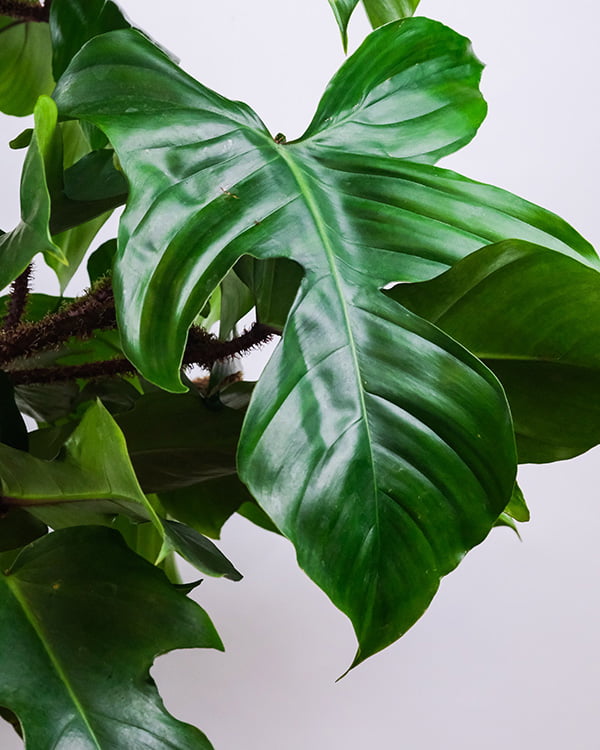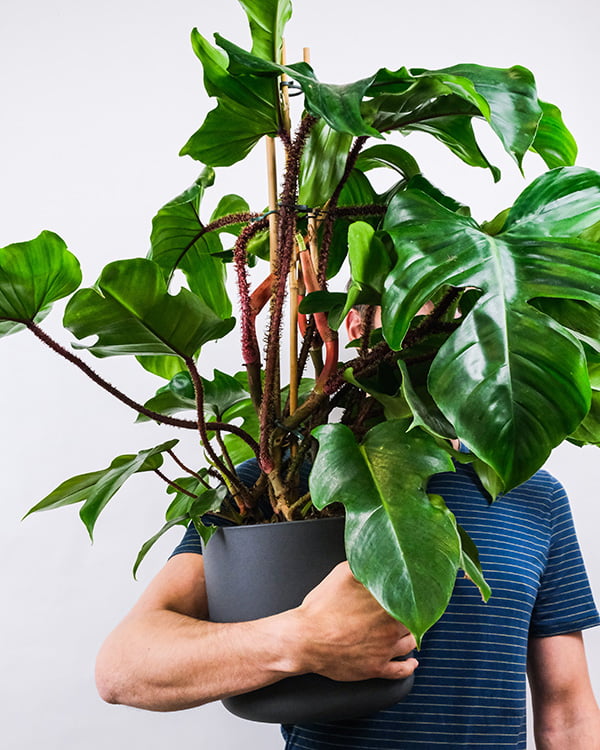The Philodendron Squamiferum is a rare, large, and in-charge house plant! It's easy to care for and rewards you with long, climbing vines filled with bristled stems and deep green leaves. This plant is terrific but hard to find in the United States.
In this Philodendron Squamiferum care guide, we'll share everything you need to know to ensure your plant matures vibrantly!
Botanical Name
Common Name
Mature Size
Sun Requirement
Soil Type
Hardiness Zone
Pet Friendly
Philodendron Squamiferum
Red Bristle Philodendron, Hairy Philodendron
Up to 18 inches in length
Partial shade; Bright, indirect light
Coarser, lighter, well-drained, rich in organic matter
9-11
No
What Is Philodendron Squamiferum?
The Philodendron Squamiferum is a hairy species of Philodendron, giving it nicknames such as "Hairy Philodendron" and "Red Bristle Philodendron." Philodendron Squamiferum grows in the rainforests of Central and South America, where it climbs up the trunks of large trees. It can reach heights of 20 feet tall in the wild, and although it's unlikely to get that tall when kept as a houseplant, you'll definitely need a moss pole, and it will probably become a floor plant! The oak-shaped leaves are usually deep green, although there are variegated varieties. Its stalks are covered with fuzzy red hairs.
Philodendron Squamiferum Care Requirements
Light
When considering where to place your Philodendron Squamiferum, keep its natural habitat in mind. This is a tropical plant that grows beneath the canopy of larger trees. It receives lots of light, but it's filtered and dappled. The best location for bright, indirect light is a south-facing window. However, an east-facing window is another good option because although your plant will receive direct sunlight in the morning, it's not a harsh light. You can also help diffuse your natural light source by using sheer curtains.
Water
It's vital not to overwater a Philodendron Squamiferum plant! They are prone to root rot and fungus gnats. However, they should be kept from completely drying out too. You can use a moisture meter to monitor the moisture in the soil throughout the pot or check the soil using your finger. When the top few inches of the soil feel dry, it's time to water your Philodendron Squamiferum. If you feel moist soil, wait another day or two! If the plant gets droopy leaves, it's time to water it.
Temperature
Philodendron Squamiferum prefers warm temperatures that mimic its rainforest habitat - ideally between 59 and 77 degrees Fahrenheit. It doesn't tolerate cold temperatures and will die if the temperature falls below 59 degrees Fahrenheit for a prolonged period. Keep mindful of areas in your home where it might be colder or hotter. For a healthy Philodendron Squamiferum, keep it away from radiators, heating and cooling vents, drafty windows, and fireplaces.

Source: Unsplash
Humidity
Like all tropical plants, the Hairy Philodendron likes to live in a humid environment. A 40% humidity level is ideal, or you might start noticing brown leaf tips. If the humidity levels of your house are on the drier side, there are ways to boost the air moisture a bit.
Grouping
Plants naturally increase the humidity in the air directly around them. If you have other tropical plants, group them together.
Pebble Tray
Fill a tray with pebbles, then fill it with water to just under the top of the pebbles. Place your pot on the pebbles. Water will evaporate from the tray into the air around your plant.
Use A Humidifier
Particularly in dry climates, use a humidifier. You might benefit from a moisture boost as well!
Soil
Like all Philodendron plants, the Philodendron Squamiferum needs an airy soil mix. Its aerial roots will suffocate in the incorrect soil medium, such as pure potting soil. It will thrive if you amend the mix slightly. Add sphagnum moss or peat moss for moisture retention and coco coir or partially composted pine bark for aeration.
Fertilization
Philodendron Squamiferum is a slow-growing plant and so doesn't require heavy fertilizing. However, with the help of a little fertilizer, Philodendron Squamiferum will have lush foliage and the fastest possible growth. Apply a liquid fertilizer twice a month during the spring and summer growing seasons. Always water after fertilizing - this spreads the fertilizer throughout the soil rather than leaving it at the top and causing fertilizer stress.
Propagation
Propagating Philodendron Squamiferum couldn't be easier! You simply use stem cuttings, either in the soil or through water propagation. Here's how to do it:
Stem Cutting In Soil
Use clean shears to cut a 3-inch length of the stem, with visible nodes or aerial roots near the cut end. Make sure the cutting has at least one pair of healthy leaves at the top. Also, make sure to use a sterilized scissor to avoid bacterial infection.
Place the cutting in damp soil with plenty of sphagnum moss and coco fiber mixed in. Take care that the nodes are buried!
Maintain a constantly moist soil, and keep the plant near bright, indirect sunlight. You'll see new growth in 3 weeks!
Stem Cutting In Water
Use clean shears to cut a 3-inch length of the stem, with visible nodes or aerial roots near the cut end. Make sure the cutting has at least one pair of healthy leaves at the top.
Set the bottom half of the cutting in water, ensuring no leaves are submerged. It's best to use distilled water.
Place the cutting in a well-lit area with plenty of airflows. Change out the water as necessary.
When the roots are a few inches long, transplant the cutting into a fresh pot of soil. Keep the soil moist until the roots adjust.
Air Layering Technique
The air layer is the best propagation method and is safer than the other techniques.
Look for a section of the plant that has at least two nodes.
Prepare a moss bag by filling a plastic bag or Ziploc bag with damp sphagnum or coco coir. Be sure to leave a small opening on the bag for watering.
(Optional) Wound the stem by making a tiny cut on the chosen section of the plant and apply a moderate amount of rooting powder on the wound to promote growth.
Cover the nodes with the moss bag and enclose the stem in the peat moss or coco coir. To ensure you cover the nodes, you may need to cut the bag in some areas. Be sure to secure the covering with twist ties or hemp twines to make sure the bag stays in place.
Water the propagation section through a small opening and ensure the developing root ball doesn't dry out.
After about 3-5 weeks or so, check for aerial roots poking out of the moss bag. Remove the moss bag, cut the propagated section from the mother plant, and transplant it into a pot.
Pruning
Philodendron Squamiferum is easy to prune and best-done in spring and summer. If you see any yellow or brown leaves, simply remove them. You will want to use clean pruning shears or scissors to snip off any unruly vines.

Source: Unsplash
Common Problems
Like most Philodendron species, Philodendron Squamiferum sometimes has problems with the typical houseplant pests and diseases.
Pests
Spider mites and fungus gnats are the two pests that tend to bother Philodendron Squamiferum. These are easy enough to prevent and treat with neem oil, and you can apply insecticidal soap treatment if the infestation is particularly bad.
Diseases
Philodendron Squamiferum can show signs of root rot through its plant's leaves. A fungal infection that is caused by overwatering, thereby suffocating the roots. Stop watering and let the soil completely dry out. If possible, unpot the plant, then cut away dead roots, rotting stalks, and brown leaves. Repot using a fresh potting medium.
Is Philodendron Squamiferum Toxic To Pets?
Philodendron Squamiferum plants are toxic to both humans and pets due to calcium oxalate crystals. If the leaves or stems are ingested, symptoms such as burning and swelling lips and tongue, vomiting, and diarrhea can occur.
